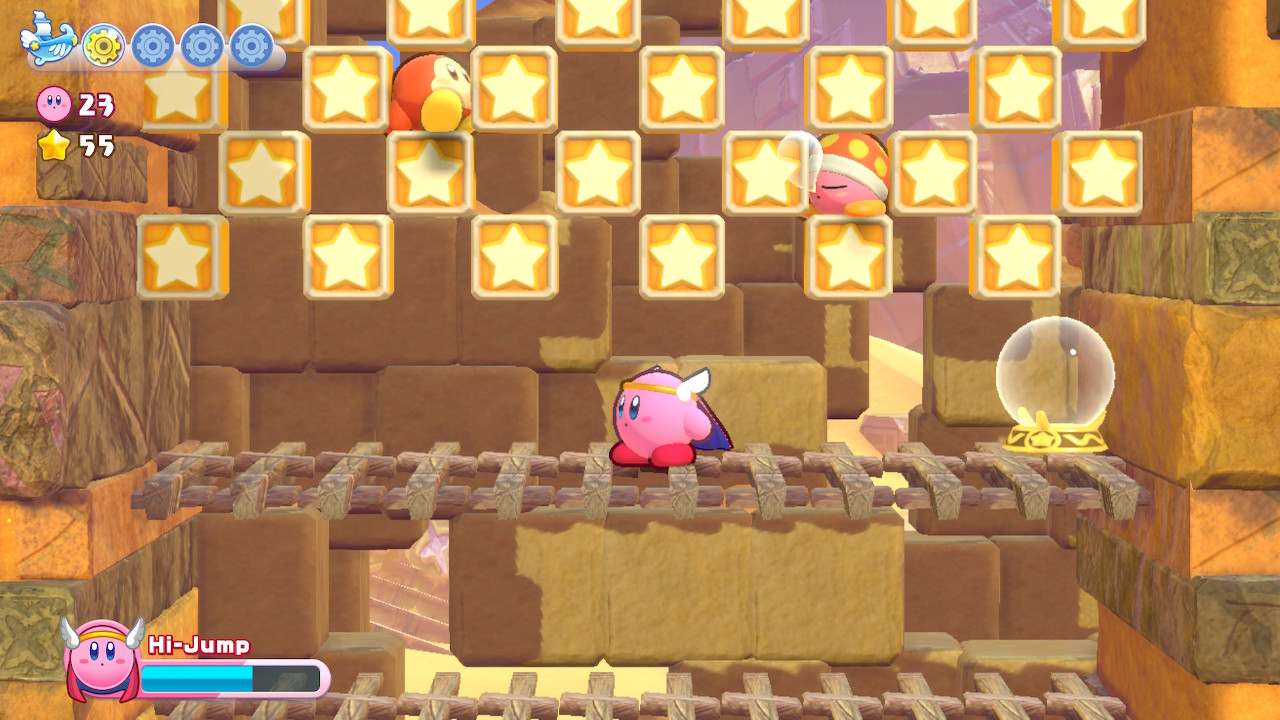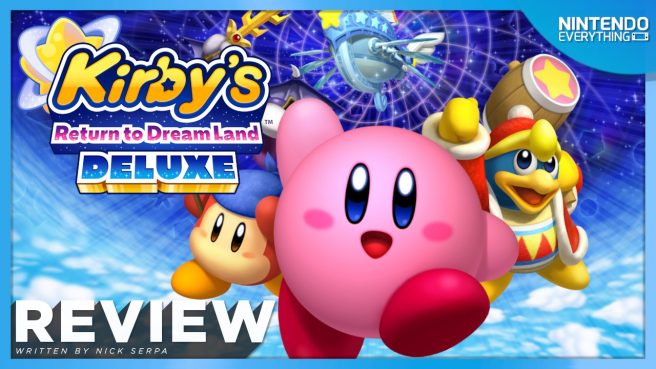[Review] Kirby’s Return to Dream Land Deluxe
System: Switch
Release Date: February 24, 2023
Developer: HAL Laboratory
Publisher: Nintendo
The original Wii launch of Kirby’s Return to Dream Land has always felt like a particularly important game for the franchise; at the time it released, it had been in development in some form for over a decade, after multiple attempts at creating a new mainline Kirby game never reached fruition. That’s a big part of the reason why Kirby’s Return to Dream Land Deluxe, a remaster of the 2011 original, feels like such a fitting way to wrap up the pink puffball’s 30th anniversary celebrations – it’s a testament to just how much the franchise has grown and evolved since then. But how well does this classic Kirby game hold up after all these years, and is the new content added into this remaster strong enough to justify a full-price rerelease?
Video Review
Written Review
The first thing returning players will notice about Kirby’s Return to Dream Land Deluxe is the updated visuals and presentation. While I was initially skeptical about the thick black border that now outlines all characters, it really grew on me over time, as it helps them pop from the background environments in a very satisfying way. The game looks outstanding in motion, and stages have substantially more detail and life to them than in the original Wii version. Even loading screens have gotten a bit of flair to them, animating a shower of falling stars as Kirby enters a new room. Cutscenes have been reanimated to resemble the pop-up storybook style of the original GameCube prototype more closely, and new animations have been added to make gameplay even smoother. It’s a beautiful package that has clearly been crafted with love, and it feels like a modern Kirby title rather than a decade-old Wii game, which is impressive.

While there is some new content added to Kirby’s Return to Dream Land Deluxe, some if it isn’t accessible until the main story mode has been completed. Fortunately, the campaign is a blast from start to finish – this time around, Kirby (and friends, if you play it in multiplayer mode) are tasked with helping a creature named Magolor repair his airship after a dimensional rift causes him to crash-land on Planet Popstar. While the story isn’t the deepest in the world, there are some interesting moments that take the plot in some unexpected directions later on, and that establish an interesting foundation for the new Magolor Epilogue mode that’s been created for this remaster.
The main story mode is certainly simpler in its direction compared to later entries in the Kirby franchise – there are no massive suits of robot armor to pilot here, nor any of the Mouthful Mode shenanigans of last year’s 3D game. Instead, Return to Dream Land Deluxe focuses first and foremost on tight, responsive platforming, and providing a huge range of Copy Abilities to let players experiment with creative ways to dispatch enemies (after sucking them up and stealing their powers, of course). This remaster introduces two brand new Copy Abilities, Sand and Mecha; both successfully expand Kirby’s moveset in fun new ways, but they are a small addition overall and don’t significantly change how the campaign plays out. Still, I was consistently impressed with just how great all of Kirby’s abilities felt to use. They all feel distinct from each other, with unique directional attacks for each one, and all of them feel genuinely useful in different situations. Finding new abilities while progressing through stages is a huge part of what makes Kirby games such a joy to play and Return to Dream Land Deluxe certainly maintains that high standard of quality.

Kirby does still have a few interesting tricks up his sleeve this time, though. Perhaps the flashiest are his “Super Abilities,” which grant him temporary, tremendously powerful attacks that fill the entire screen and damage swaths of enemies. These are often handed to players at the end of stages, and while they’re a ton of fun to use – they basically make Kirby an unstoppable force – they’re not particularly deep. Kirby also has a “Super Inhale” ability that, by holding down the B button, lets him suck up multiple enemies and blocks in a single gasp. While this is useful in certain predetermined situations, it’s not particularly compelling to me, personally – it doesn’t affect the overall flow or strategy of completing stages other than the situations in which it’s required to progress.
While I never needed to rely on a certain Copy Ability or Special Ability to complete a stage, players with a puzzle-solving mindset will notice opportunities to use these skills to unlock alternate routes through levels or obtain difficult-to-reach collectibles. Kirby games have a reputation for being “too easy” for some players, and while it’s true that reaching the end of a stage is usually relatively simple to accomplish, players who want to collect each world’s Energy Spheres will face a tougher challenge. In addition to branching routes through stages, there are also portals to another dimension hidden in many levels; these transport Kirby to optional gauntlet-style stages, in which a glowing wall of cosmic stardust threatens to crush him if he can’t reach the goal fast enough. So, players who want to see as much of the main campaign as possible will have a lot of opportunities to take on tougher challenges before the final boss fight, although it never gets overwhelming (that final boss is no pushover though!)

Surprisingly, Kirby’s Return to Dream Land Deluxe adds some new accessibility features that can make the game easier if players so desire. A new Helper Magolor mode makes it so that Kirby can be rescued when he falls into pits and will receive extra health items when taking a lot of damage. Items can also now be stored and used later by pushing the X button, and extra lives are now retained when the game is relaunched. These are little things, but I appreciate their inclusion as it makes the package more approachable for some types of players, which is always a good thing in my book.
It’s worth noting that the entire campaign is also playable in co-op, which up to three other players can drop in and out of at any time. This has been tweaked from the original release – now, everyone can play as a different-colored Kirby, or they can choose to play as one of Kirby’s friends (enemies?) – King Dedede, Meta Knight, or Waddle Dee. While I’m sure some folks will find this mode of play fun, my wife and I found that levels didn’t really feel optimized for multiplayer play in the way we had hoped. I disliked how the game would teleport players close to each other if one strays too far ahead, as it meant that we basically had to be always right next to each other in a stage – which, given how hectic later levels can get, wasn’t always practical or fun. It also feels like an oversight that that if Player 1 dies, the whole team must restart from the last checkpoint, regardless of if other players are still alive and kicking. Stages also just don’t really feel built for multiplayer, and things often just feel cramped and busy. Playing solo feels like the best way to play this story mode, without a doubt.

After beating the main story mode, a brand-new single player experience called Magolor Epilogue becomes available, and it’s an excellent addition that expands the gameplay loop in some innovative ways. This two to three-hour experience strips Magolor of his abilities after the events of the main game, and tasks players with helping him regain them by collecting Magic Energy and clearing stages. What’s interesting is that players can decide which abilities they want to invest their upgrade points in, and in what order. Health, flying, attacking, and a wide range of special attacks can all be unlocked and upgraded over time. It’s not very deep or challenging – this is not an RPG or a Metroidvania-style experience by any stretch. But it does shake up progression a little bit, and how players choose to upgrade Magolor will affect in what order certain stages become playable, so there are some fun choices to make. I wish it was a more substantial experience, as it feels like it wraps up a little too quickly, but it’s a fun if inessential diversion.
The other big addition to Kirby’s Return to Dream Land Deluxe is its new Merry Magoland mode, which collects most of the minigames from the original release, adds in a few new ones, and packages them into a hub world of sorts. While the sub-games that can be played here are, disappointingly, the exact same ones that are playable in Magolor’s ship in the campaign mode, Merry Magoland attempts to add some progression paths and in-game rewards to make playing the games more interesting.

As Kirby plays the sub-games, he will earn stamps on stamp cards, with better performance resulting in more stamps and faster accumulation of rewards. Additionally, each sub-game now has its own set of Missions to complete – these are criteria that require players to win a certain number of times, or complete certain specific objectives in each subgame to clear. Rewards for progressing through these progression paths include unlockable masks that Kirby and friends can wear in the game’s other modes, of which there are a shocking amount – some of them even, delightfully, change Kirby’s voice in-game. Players can also obtain “souvenirs”, which are helpful items that can be brought into stages in the main game, like health-restoring Maxim Tomatoes and such.
While I appreciate that HAL has attempted to add new reasons for folks to play the subgames with more frequency, unfortunately, I didn’t find any of the ten sub-games – not even the two new ones – compelling enough to want to play them dozens of times. There just isn’t much substance to any of them, even with their varying difficulty modes. There are essentially two types of sub-game present; those based on reflexes and timing, and those focused on arena-style combat shenanigans. While the sub-games all have different presentations, I felt like I was just playing variants of the same few types of games, and quickly lost interest. Smash Ride, Booming Blasters, and Checkerboard chase, for example, all have players trying to push or shoot another player in a battleground setting, just with minor tweaks to their rules or mechanics. Ninja Dojo and Kirby on the Draw are both carnival-style shooting gallery-type games. The remaining ones are based on having quick reactions to timing-based challenges. In other words, once you’ve played a few of the sub-games, you’ve basically played them all. They just don’t feel meaty enough to play for any length of time, and I think even kids will get bored quickly.

The single exception to this is Samurai Kirby 100, which is just so delightfully strange that it feels like it warrants a separate mention. Here, players can play the Samurai Kirby minigame – which tasks players with reacting quickly to defeat their opponents in a single strike – against 100 other players. The catch is that, while you can practice, you can only compete once a day! I couldn’t tell you why this mode exists, but it’s strange and made me laugh each time I played it, so that counts for something.
Kirby’s Return to Dream Land Deluxe does have a few other modes that unlock after beating the main game, fortunately – Extra Mode reworks the Story Mode to make it tougher, reducing Kirby’s health, adding tougher and more dangerous enemies, and even adding a new boss. There’s also an Arena Mode that essentially acts as a Boss Rush style mode, in which a single death will start players from the beginning. So, players who fall in love with the game and want to replay it will certainly have plenty to dig into.
The Verdict

Ultimately, even if some of the new content falls a bit flat, Kirby’s Return to Dream Land Deluxe is still a compelling package and a great remaster of an already-excellent Kirby game. New players will be experiencing an incredibly polished and refined Kirby campaign that becomes progressively more satisfying as its difficulty ramps up, and the new Magolor Epilogue adds a few extra hours of new ideas and unique progression mechanics for a Kirby game. While I didn’t enjoy the sub-games and Merry Magoland mode as much as I had hoped, the sheer quantity and variety of ways to play will be enough to satiate even the most discerning Kirby fan, and returning players who are nostalgic for the original will likely be impressed with the countless small ways in which the original game has been tweaked and improved. Kirby’s Return to Dreamland Deluxe is a great Kirby remaster for fans both new and old, and sets a high bar for whatever our pink protagonist’s next adventure might look like.
Kirby’s Return to Dream Land Deluxe copy provided by the publisher for the purposes of this review.
